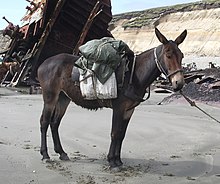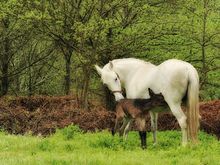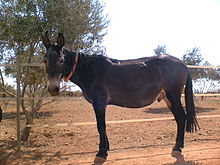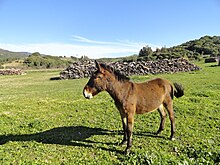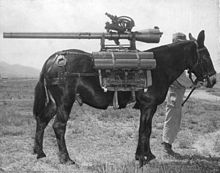Mule
The mule , also called mule , (from Latin mulus , 'mule', 'mule') is the cross product of a domestic horse mare with a domestic sire . The animal thus conceived is a hybrid from a biological point of view . A hybrid of the reverse combination, i.e. a cross between a (house) horse stallion and (house) donkey mare , is instead called a mule in German .
As hybrids, with rare exceptions, mules are not able to reproduce. Mules are easier to breed than mules and, due to their greater endurance and insensitivity compared to horses , are used as draft and pack animals , but are also well suited as mounts .
Appearance
A mule is usually larger than its donkey father and slightly smaller than the horse mother. It looks more like the horse, not least because of the large and stretched head and its fur , which despite the thicker skin looks very similar to the horse's fur and in many cases even resembles it. However, the mule retains the longer ears , probably as the dominant genetic trait of its donkey father . On the other hand, mules have smaller nostrils than horses and the four limbs are rather slender. The tail of mules is similar to that of a horse - which is why it is also called a tail - and, unlike donkeys, has no tassel . The coat colors can vary as with the horses, most often these are brown, black-brown or black, more rarely gray and extremely rarely white. There are also piebald mules, mostly in the colors white / light brown or white / dark brown. In animals with darker fur colors, the area around the mouth is often white or whitish (flour mouth), similar to that of donkeys. Usually mules with a height between 140 and 155 cm are pulled, depending on the breed of the parents there are also larger (up to 190 cm) or much smaller mules.
nomenclature
“Maulpferd” is an unusual but formally correct name for the mule. While the mule is very similar to the donkey, the mole is phenotypically an intermediate form between horse and donkey. That is why the mule, unlike the mule, has been given a colloquial name that is independent of the horse.
breed
When the genetic makeup of horse mare (2n = 64 chromosomes, n = 32) and donkey stallion (2n = 62 chromosomes, n = 31) is mixed up , an odd set of chromosomes is created , which usually does not allow the formation of sex cells. Nonetheless, mules can perform the sexual act and also have a natural sex drive, although not as strong as horses. Stallions are always sterile, but there are occasional fertile mares. The greater similarity of the mule to the mother (horse) is due to non-chromosomal inheritance . The maternal egg cell brings the main part of the cell organelles into the zygote , so that maternal characteristics predominate in the branch generation. The mule and mule are prime examples of imprinting .
Mules are usually larger than mules because the mother animal sets a limit on size and a horse mare is generally larger than a donkey mare. Foals grow up with their mother and are significantly influenced by her; the mule foal is raised “as a horse”, the mule foal “as a donkey”.
In France , particularly large Poitou donkeys are raised especially for mule breeding. By crossing them with Poitevin mares, they are used to breed a large, rustic mule breed, the Poitevin mule.
properties
Mules are considered good-natured and straightforward, and in contrast to horses, they are also far less shy. They are more evenly resilient than horses and recover very quickly from exertion. This is associated with a particularly high life expectancy of 45 to over 50 years, and in individual cases even more. As pack animals, mules are far more good-natured, they can transport around 150 kg around 30 to 40 km in a day. As draft animals, they are more enthusiastic and more persistent than horses, which is why they were generally preferred by owners of animals used in agriculture . Mules have proven themselves especially when pulling plows on difficult soils made of clay minerals , which is why they - especially in the USA - acquired a reputation for particular stubbornness due to their straightforwardness and willpower ( stubborn like a Missouri mule = " stubborn like a mule from Missouri") . Because of their thicker skin, mules are far less sensitive to high or low temperatures and unfavorable weather such as rain or snow. Mules have a much more robust health constitution and also have harder teeth, which simplifies keeping, use and feeding, especially under difficult geographical and / or climatic conditions. They also show a certain natural resistance to insects and parasites . The hooves of a mule are harder than those of a horse and, similar to those of a donkey, are adapted to stony ground and are geared more towards surefootedness than speed. The mule combines the performance of a horse with greater stamina with the surefootedness of a donkey in the field. Nevertheless, a mule used primarily as a mount can briefly run at speeds of up to 60 km / h if necessary.
In summary it can be said that mules have the level-headedness, endurance and surefootedness of a donkey in combination with the straightforwardness, strength and courage of a horse. A mule is also a good mount for inexperienced riders, which is generally easy to control and, with good training, does not lead to any surprises.
Mules get on very well with other animals, but are generally far less tolerant of dogs than horses, they are also far less shy and do not tend to simply flee when in danger. You can with all hooves in all directions turn out and are generally able to her rider to attack by wolves (Europe) or Pumas to defend (Central and South America). Cases have been documented in which a mule drove away or even killed corresponding attacking predators with hoof blows and kicks.
Charles Darwin wrote of the excellent physical properties of the mule: “The mule seems to me to be a very amazing animal; it seems that art has surpassed nature here. "
history
Mules are already documented from the ancient Orient . Perhaps the Sumerians already bred mules, but crosses between donkeys and onagers are documented from this period . Mules are also mentioned in Greek literature.
In ancient times , mules were considered the noblest animals of all. For this reason the veterinarians in the Roman Empire were not called horse doctors (equomedici), but mule doctors (mulomedici).
In the kalkriese ( Lower Saxony ), the remains of an adult mule, possibly in the year 9 n. Chr. Found in Varus Battle had been killed. As the remains of a tiller cap show, it was used as a draft animal. The remains of five mules, mostly of a young age, were also found in the Roman camp of Dangstetten , which was established by the Legio XIX in the course of the Alpine campaign (15 BC) , which suggests that they were used as draft animals. Some of them have been cut up, so they may have been eaten.
However, bone finds from mules are rather rare. A reliable distinction between mule, horse and donkey is made primarily on the basis of the teeth. However, overlapping features are documented.
In the Middle Ages as well as in more recent times , mules reached all parts of the world and played an important role as pack animals, especially in geographically and climatically more difficult areas.
In both world wars these animals were used in large numbers in practically all theaters of war due to their favorable properties, in the First World War mainly in mountain troops , in the Second World War also in colder climates such as the steppes of the Soviet Union and in tropical regions such as Southeast Asia .
Since the 1950s, the number of mules in the industrialized countries has fallen sharply after the steadily increasing introduction of modern agricultural machinery and trucks . In some countries such as B. in the USA their number even reached historic lows.
Today mules continue to play an important role in agriculture and as a means of transport in less developed regions of the world . In addition, they have retained their importance for military purposes in mountainous and inaccessible areas to this day. In Europe and the USA, mules are still bred and kept in private hands on a smaller scale, albeit more for private enjoyment and to maintain tradition.
use
Mules are used, among other things, as draft and pack animals, mounts, for military purposes (training horses ) or for the transport of valuable cargo . Due to their efficiency and surefootedness, mules have been used particularly often in mountain troops in history , including in columns in both world wars as pack animals for the transport of weapons, ammunition and supplies.
Before the modern infrastructural development of the Alpine region, the robust mules played an important role for centuries on the trade routes over the mountains on the mule tracks .
Mules could also prove themselves in private use as riding animals, they were far stronger and faster than donkeys, at the same time much less shy than horses and, on top of that, much cheaper to buy and maintain than the latter. As a mount they were often found in the Alpine countries, southern Europe (especially in Sicily ), South America and the southern states of the USA.
Mules were the first choice as draft animals, especially in warmer climates, as they could cope with the prevailing heat far better than horses and were also able to perform more and longer with less feed consumption. So it was that mules early to draw mine - Loren were used. From around 1860 they pulled the horse-drawn trams in Central and South America, the southern states of the USA, some countries in Africa and, in some cases later, also in Spain , contrary to the usual practice in other parts of the world . Around the turn of the century, like horses, the powerful mules, which are cheaper to buy and maintain - but in some cases stubborn - were replaced by electric tram cars in most businesses . However, a few “mule railways” operated until the 1920s and 1930s - and two smaller railways of this type were in operation in Brazil until the 1960s.
Even today, mules have not lost their importance and function as pack animals in impassable areas of the world, despite all technical progress. So for example, were after the heavy earthquake in northern Pakistan and neighboring Kashmir in autumn 2005, more than 2,000 mules of animal transport units ( English : Animal Transport Units - ATU) of the Pakistani army mobilized to supply the affected population in the difficult to access area.
In some cases, mules that were formerly part of the armed forces found a second civilian use. For example, mules taken out of service by the British Army in Hong Kong in 1975 were used for therapeutic riding for years after their release and appropriate training on site .
The largest mule population in Germany is in Bad Reichenhall in action as pack animals for the mountain hunters of the German armed forces there ( deployment and training center for pack animals 230 ). Even if their number has decreased somewhat compared to earlier times, these animals are still used to this day, especially in winter, to care for farms and huts that are remote and inaccessible by vehicles.
Pictorial representations
From the Assyrian royal palace in Nineveh there are mule representations from around 1000 to 500 BC. Known, however, according to some experts, these may be even older.
See also
literature
- H. Henseler: A fertile mule. Published by M. & H. Schaper, Hannover 1925.
- W. Schlueter and others: Archaeological evidence of the Varus Battle? The investigation in the Kalkriese-Niewedder depression near Osnabrück . In: Germania. 70, 1992, pp. 307-349.
- Hans-Peter Uerpmann and Margarethe Uerpmann: Mules in the Roman army at the time of the campaigns of conquest in Germania. In: Mostefa Kokabi, Joachim Wahl (Hrsg.), 8th working meeting of osteologists: Contributions to archeozoology and prehistoric anthropology. 8th working meeting of osteologists, Konstanz 1993. in memory of Joachim Boessneck . (= Research and reports on prehistory and early history in Baden-Württemberg. 53). Theiss, Stuttgart 1994, ISBN 3-8062-1155-8 , pp. 353-357.
- Ernst Bödeker: Mule breeding and keeping . Hanover 1908.
gallery
Mule by Eadweard Muybridge (1893)
Mule as a draft animal on the New Orleans (USA) horse-drawn tram around 1890
Web links
- Peter Lehmann: Mule. In: Historical Lexicon of Switzerland .
Individual evidence
- ↑ Supply mules in Kashmir (English)

